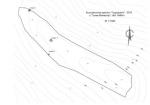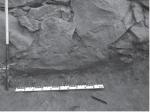Summary (English)
EXPLORATIONS NEAR THE VILLAGE OF GOLYAM MANASTIR (Stefan Bakardzhiev – st_bakarjiev@abv.bg) The fortress was 585 m long, 40 – 80 m wide and covered an area of c. 4.2 ha. Sondage I was carried out in the northwestern part of the fortress. A section of the fortification wall, 8 m long, was explored. The wall was preserved at 1.20 – 1.50 m in height and was 2.90 m wide, built of dry roughly cut stones. The sterile layer was at 55 – 60 cm in depth. The upper stratum was 15 – 20 cm thick and contained material of the 3rd – 4th centuries AD. The top stratum contained material of the 3rd – 6th centuries AD. Thracian sherds of the 8th – 7th centuries BC were discovered in the emplectum of the fortification wall. Sondage II was carried out on the southwestern fortification wall. A section of the wall, 4.50 m long, was explored. The wall was preserved at 1.90 – 2.10 m in height and was 2.10 m wide, built in opus emplectum. Three courses in dry masonry were constructed above the foundation of the wall. The upper part of the wall was built with a bonding medium of mortar. The two building techniques probably reflected two construction periods. The top stratum was 25 – 65 cm thick and contained material of the 3rd – 6th centuries AD. The lower stratum was c. 40 cm thick and contained material of the 5th – 6th centuries AD. The third stratum was c. 40 cm thick, contained material of the 4th century AD and was related to the construction of the fortress. The lowest stratum contained material of the 3rd – 4th centuries AD, including a Roman colonial bronze coin with a countermark of the middle of the 3rd century AD and Thracian sherds of the 8th – 7th centuries BC. Sondage III was carried out in the western half of the fortress. A building, 8 m by 6 m in size, was discovered. It had one room and an entrance situated on its eastern wall. The walls were 85 – 90 cm wide and were built in rubble masonry, while their upper part was constructed of sun-dried bricks. The roof was covered with tegulae and imbrices. The building existed in the 6th century AD and was burned during the AD 590s, judging from a hoard of nine coins of Justinian I and Justin II.
- Stefan Bakardzhiev - Museum of History - Yambol
Director
Team
Research Body
- Museum of History - Yambol






![Download [PDF]](/excavation/skins/fasti/images/results/download_sml.png)

